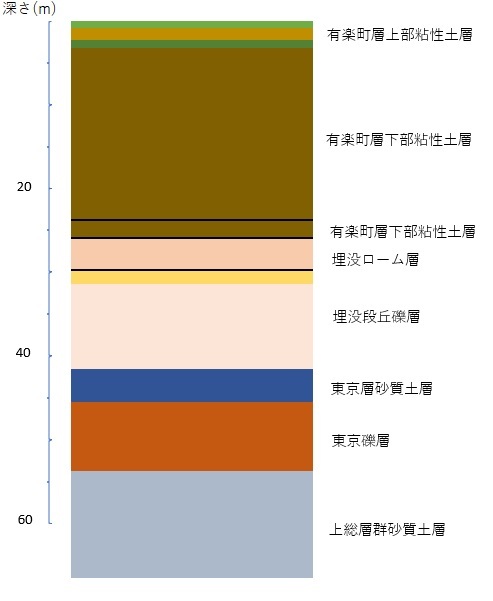■Task
※営業時間を確認のうえ、ご訪問ください。
キャッシュオーナーに、以下の答えを送信してください。(ログには書かないでください。)
※キャッシュオーナーからの返事は待たずにFoundログをつけてかまいません。
※公開座標へは、1階Reference pointの入口(佐川急便営業所のすぐ横の入口)から入れます。
<Q1>
公開座標の情報をみると、ある層からN値が高くなっていることが分かります。
N値が50を超えるのは地下約何メートルの、どの層からですか。
<Q2>
上記の層からN値が高くなる理由はどのようなものと考えられますか。あなたの考えを述べてください。
■東京スカイツリー
公開座標には自立式電波塔として世界一を誇る東京スカイツリーがあります。その高さはなんと634m。
日本は地震国ですが「心柱制振」の技術や、三角形から円形に変わっていく構造など様々な工夫が凝らされて建設されました。そして何よりもこの高層タワーを支えるには安定した地盤が大切です。
このEarth cacheで、東京スカイツリーが立つ東京の地層・地盤について学びましょう。
公開座標で、東京スカイツリーの地盤の地層を説明したものを確認することができるので参考にしてください。
まず、今いるところの足下の地面、そしてその下に続く何層もの地層をイメージしてみてください。
■東京スカイツリーの下の地層概要
東京スカイツリーの地下には「有楽町層」と呼ばれる地盤が25m前後の厚さで広がっています。
その下に「埋没ローム層」、「埋没段丘礫層」があります。
さらに下の地下約40mより深い層に、堅固な「東京層」が存在します。
東京スカイツリーの基礎は、地下約50mに達する壁厚1.2mの鉄骨鉄筋コンクリート造節付き連続地中壁杭(ナックル・ウォール)が打ち込まれていて、東京層の深さにまで達しています。
このような地下深く支える”根”が、東京スカイツリーという大きな木を支えるのには必要です。
■東京スカイツリーの下の地層
■有楽町層
東京の下町に広がる沖積層の上部で、粘土・砂が主です。
「第四紀完新世(1万年前)」から現在までに堆積した地層で、砂や粘土、シルトなど軟らかい海成の泥から主に成る非常に軟弱な層です。
■埋没ローム層
粘性質の高いロームで構成された地層をローム層といいます。
日本では「火山灰」を起源とする説が長くよく知られていたが、関東ローム層も実は「火山灰」ではなく火山近傍から火山性の細粒子が風によって舞い上げられ堆積した「風塵」であるという説がここ数十年で出ています。
いずれにせよ、ロームの定義は土壌中の粒径組成比率のみであり、火山起源物質であるかどうかには依らない。
■埋没段丘礫層
東京湾に面した東京低地には数段からなる埋没段丘が分布し、最終氷期最盛期以降の堆積物に覆われています。
これらの埋没段丘のうち、東京スカイツリーのある隅田川~荒川エリアの地表面下30~40mに分布するものは本所埋没段丘と呼ばれ、埋没段丘礫層は厚さ4~6mの礫層から構成されています。
■東京層
更新世後期の海成層です。
約14.7万年前~13.2万年前までの間に起きた海水準上昇(下末吉海進)によって、現在の関東平野が広がる地域に「古東京湾」と呼ばれる広い内湾が形成され、そこに堆積した浅海・内湾性の堆積物である礫層や砂質土層から成ります。

■N値
N値とは土の締まり具合や強度を求める基準となる数値です。
N値を用いて、地盤の硬さや締まり具合を評価したり、基礎や地盤反力等の設計に必要な地盤定数(土質定数)の推定に利用できます。
大型建造物の場合は、N値が50以上であれば非常に強固な地盤(岩盤)であり適切と言われます。
=====English=====
■Tokyo Sky Tree
The published coordinates include the Tokyo Skytree, which boasts the world's largest free-standing radio tower. Its height is 634m.
Although Japan is an earthquake-prone country, the building was constructed using various innovations such as the `Shinbashira vibration damping',`technology and a structure that changes from a triangular shape to a circular shape'.
Above all, a stable ground is important to support this high-rise tower.
With this Earth cache, let's learn about the strata and ground of Tokyo where Tokyo Skytree stands.
Please use the published coordinates as a reference, as you can check the explanation of the strata of the ground of Tokyo Sky Tree.
First, imagine the ground beneath your feet and the many layers of strata beneath it.
■Outline of the strata under Tokyo Sky Tree
Beneath Tokyo Skytree, there is a layer of ground called the "Yurakucho layer" that is approximately 25 meters thick.
Below that, there is a ``buried loam layer'' and a ``buried terrace gravel layer.''
Further down, approximately 40m deeper underground, lies the solid Tokyo layer.
The foundation of Tokyo Sky Tree is made up of continuous underground wall piles (knuckle walls) with knots in steel-framed reinforced concrete with a wall thickness of 1.2 m that reach approximately 50 m underground, reaching the depth of the Tokyo layer.
These deep underground roots are necessary to support the large tree like "Tokyo Skytree".
■The strata under Tokyo Sky Tree
■Yurakucho layer
This is the upper part of the alluvial layer that spreads over downtown Tokyo, and is mainly made of clay and sand.
This is a geological layer deposited from the ``Quaternary Holocene'' (10,000 years ago) to the present, and is an extremely soft layer consisting mainly of soft marine mud such as sand, clay, and silt.
■Buried loam layer
A stratum composed of highly viscous loam is called a loam layer.
In Japan, it has long been well-known that the Kanto loam layer originates from volcanic ash, but the Kanto loam layer is actually not volcanic ash but wind dust, which is made up of fine volcanic particles blown up by the wind from near volcanoes. This theory has been around for the past few decades.
In any case, the definition of loam is only based on the particle size composition ratio in the soil, and does not depend on whether it is a material of volcanic origin.
■Buried terrace gravel layer
Several levels of buried terraces are distributed in the Tokyo Lowland facing Tokyo Bay, covered with sediments dating back to the peak of the last glacial period.
Among these buried terraces, those distributed 30 to 40 meters below the ground surface in the Sumida River to Arakawa area, where the Tokyo Sky Tree is located, are called Honjo buried terraces, and the buried terrace gravel layer ranges from a gravel layer with a thickness of 4 to 6 meters. It has been constructed.
■Tokyo layer
It is a marine stratification from the late Pleistocene.
Due to the sea level rise (Shimosueyoshi transgression) that occurred between approximately 147,000 and 132,000 years ago, a wide inner bay called "Old Tokyo Bay" was formed in the area where the current Kanto Plain extends. It consists of sand and gravel layers and mud layers, which are deposits from shallow seas and inner bays.
■N value
The N value is a value that is used as a standard for determining the compactness and strength of soil.
The N value can be used to evaluate the hardness and compaction of the ground, and to estimate ground constants (soil constants) necessary for designing foundations, ground reaction forces, etc.
For large buildings, if the N value is 50 or more, the ground (rock) is extremely strong and is considered appropriate.
■Task
※Please check the opening hours before visiting.
Please send the answer to the cache owner.
(Don't write it in the log.)
(※No need to wait cache owner's response.)
<Q1>
Looking at the public coordinate information, you can see that the N value increases from a certain layer.
Approximately how many meters underground and in what layer does the N value exceed 50?
<Q2>
What do you think is the reason for the high N value from the above layer? Please tell me what you think.